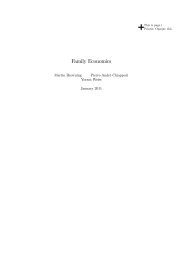The relationship between DSGE and VAR models - cemmap
The relationship between DSGE and VAR models - cemmap
The relationship between DSGE and VAR models - cemmap
You also want an ePaper? Increase the reach of your titles
YUMPU automatically turns print PDFs into web optimized ePapers that Google loves.
3.2 Summary of stage 2 <strong>and</strong> discussion<br />
Once the <strong>DSGE</strong> has been log-linearized <strong>and</strong> written in the state-space form (2), which is equivalent<br />
to a <strong>VAR</strong>MA, the question of whether the impulse-response functions implied by the <strong>DSGE</strong><br />
can be meaningfully compared to the impulse-response functions obtained by a <strong>VAR</strong>(1) crucially<br />
depends on whether a <strong>VAR</strong>.1/ representation of the model exists. <strong>The</strong> condition to check<br />
is that the eigenvalues A B D 1 C are strictly less than one in absolute value. If the condition<br />
is satised, the MA representation of the system is fundamental, <strong>and</strong> it is thus possible to recover<br />
the structural shocks <strong>and</strong> their associated impulse-responses from the innovations <strong>and</strong> the<br />
impulse-responses computed from a <strong>VAR</strong>, by imposing suitable identifying restrictions. This<br />
in turn means that it is meaningful to use S<strong>VAR</strong> impulse responses for <strong>DSGE</strong> model estimation<br />
<strong>and</strong> validation.<br />
An issue that arises in stage 2 is that it cannot be performed when the model implies stochastic<br />
singularity, which occurs when there are fewer shocks than observables, i.e., n " < n y : This<br />
is a common occurrence in <strong>DSGE</strong> <strong>models</strong>, where a small number of structural shocks typically<br />
drive a larger set of variables, linked by identities that might not hold in the data. <strong>The</strong> literature<br />
has dealt with stochastic singularity in three ways: 1) by only using a subset of the observable<br />
variables Y t in the estimation of the <strong>VAR</strong> model; 2) by increasing the number of structural<br />
shocks in the <strong>DSGE</strong> model; <strong>and</strong> 3) by using all available observables but adding measurement<br />
errors in the <strong>DSGE</strong> model (e.g., Irel<strong>and</strong>, 2004). Each approach has drawbacks <strong>and</strong> involves<br />
arbitrary decisions on the part of the econometrician which may have important effects on the<br />
results of the analysis. Dropping variables from the estimation results in a loss of information<br />
<strong>and</strong> opens up the possibility that the results will differ depending on which subset of variables<br />
is used. Shocks that are added to the <strong>DSGE</strong> model may lack a structural interpretation <strong>and</strong>,<br />
from an econometric perspective, increase the number of parameters <strong>and</strong> the chance of misspecication.<br />
For example, it is common to add preference shocks which are merely violations<br />
of rst order conditions. Like measurement error, they lack microfoundations <strong>and</strong> undermine<br />
the perceived advantage of <strong>DSGE</strong> <strong>models</strong> over <strong>VAR</strong> <strong>models</strong>, namely the advantage of being<br />
rigorously derived from micro foundations. That in turns raises the question of why we would<br />
13













